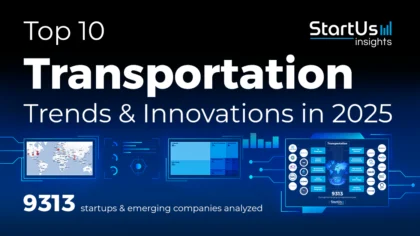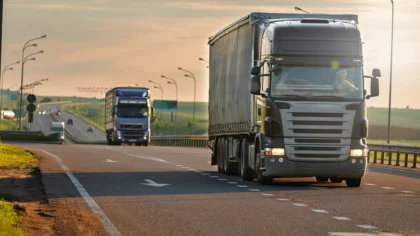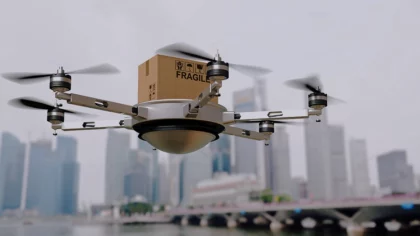The transportation sector is undergoing a radical shift driven by technological breakthroughs and immediate sustainability demands. Emerging trends include predictive maintenance, dynamic traffic optimization, and electric vehicles (EVs). Autonomous technology and on-demand services also improve mobility flexibility, while drone delivery networks and next-gen high-speed transit projects are accelerating logistics.
At the system level, 5G connectivity, blockchain solutions, and mobility-as-a-service (MaaS) platforms are creating smarter, more transparent, and user-centric transportation ecosystems. This report explores the key trends propelling transportation innovations – and what they mean for businesses, cities, and consumers.
What are the Top 10 Global Transportation Trends in 2025?
- Artificial Intelligence (AI) Integration
- Electric Mobility
- On-Demand Transportation
- Drone Deliveries
- Blockchain Integration
- Autonomous Vehicles
- Multimodal Transportation
- High-Speed Transportation
- 5G Technology
- Mobility-as-a-Service
Methodology: How We Created the Transportation Trend Report
For our trend reports, we leverage our proprietary StartUs Insights Discovery Platform, covering 7M+ global startups, 20K technologies & trends plus 150M+ patents, news articles, and market reports.
Creating a report involves approximately 40 hours of analysis. We evaluate our own startup data and complement these insights with external research, including industry reports, news articles, and market analyses. This process enables us to identify the most impactful and innovative trends in the transportation industry.
For each trend, we select two exemplary startups that meet the following criteria:
- Relevance: Their product, technology, or solution aligns with the trend.
- Founding Year: Established between 2020 and 2025.
- Company Size: A maximum of 200 employees.
- Location: Specific geographic considerations.
This approach ensures our reports provide reliable, actionable insights into the transportation innovation ecosystem while highlighting startups driving technological advancements in the industry.
Innovation Map outlines the Top 10 Transportation Industry Trends & 20 Promising Startups
For this in-depth research on the Top Transportation Trends & Startups, we analyzed a sample of 9313 global startups & scaleups. The Transportation Innovation Map created from this data-driven research helps you improve strategic decision-making by giving you a comprehensive overview of the transportation industry trends & startups that impact your company.
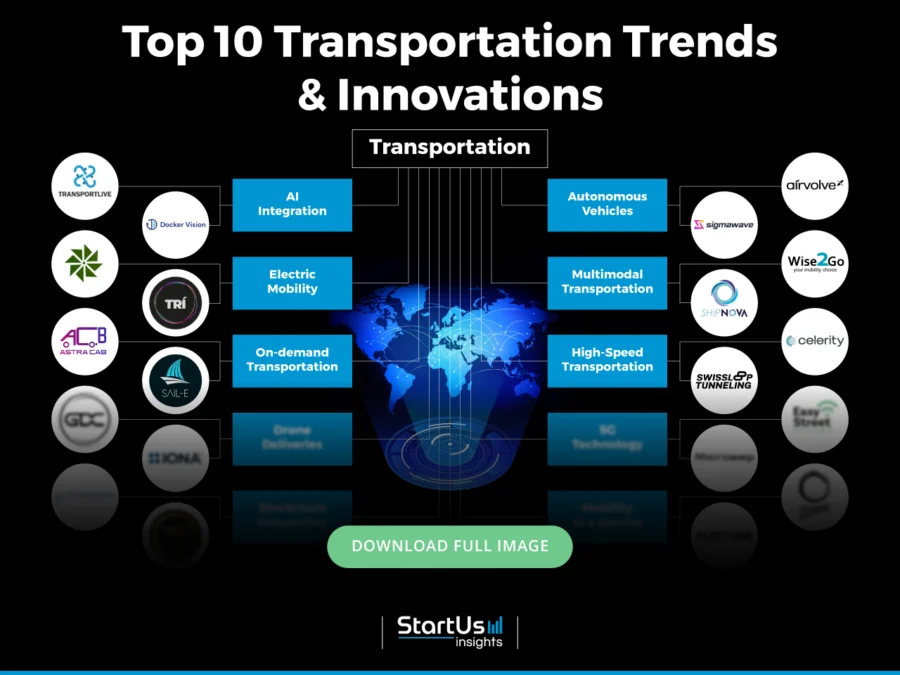
Tree Map reveals the Impact of the Top 10 Emerging Trends in Transportation
The Tree Map below outlines key trends influencing transportation in 2025, emphasizing operational intelligence, infrastructure advances, and user-focused services.
Multimodal transportation is combining public transit, micromobility, and ride-hailing, while MaaS centralizes booking, payments, and route management to support this shift. Besides, blockchain enhances transparency and security across supply chains and transit systems. Meanwhile, 5G enables low-latency communication for connected and autonomous transport.
Additionally, drone deliveries are becoming a practical solution for last-mile logistics in both urban and remote areas. These developments indicate the industry’s move toward more efficient and connected transportation networks.
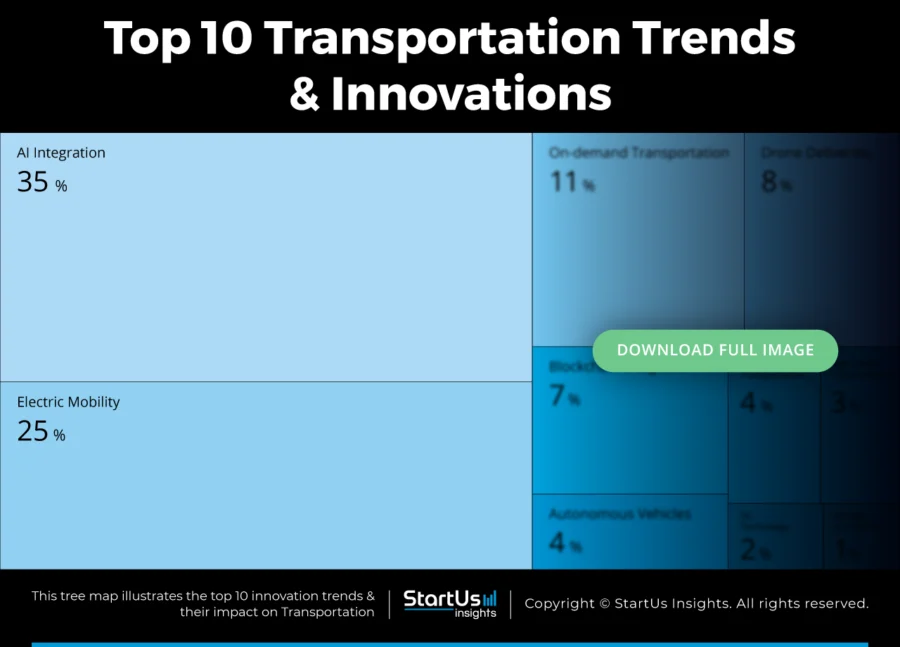
Global Startup Heat Map covers 9313 Transportation Startups & Scaleups
The Global Startup Heat Map showcases the distribution of 9313 exemplary startups and scaleups analyzed using the StartUs Insights Discovery Platform. It highlights high startup activity in the US and India, followed by the UK and Poland. From these, 20 promising startups are featured below, selected based on factors like founding year, location, and funding.

Want to Explore Transportation Innovations & Trends?
Top 10 Emerging Transportation Trends [2025 and Beyond]
1. AI Integration
In August 2024, the US Department of Transportation awarded USD 2.4 million to 12 small businesses under the Complete Streets AI Initiative, which supports AI-based improvements in multimodal roadway systems.
AI plays a key role in traffic optimization, using real-time data from roadway sensors to ease congestion, lower emissions, and enhance urban mobility.
Further, AI-powered image processing enables automated vehicle and pedestrian tracking, traffic rule enforcement, and flow pattern prediction. Natural language processing (NLP) improves human-machine interaction. This allows traffic operators to manage control systems efficiently, particularly in emergencies.
PTV Group incorporated AI-driven employee estimations into its Model2Go software in 2024 to enable cities to generate faster and more precise transportation simulations.
At the same time, computer vision advancements enhance real-time detection of safety incidents and near-misses to strengthen road safety.
The global artificial intelligence market in transportation is expected to reach USD 34.83 billion by 2034, reflecting a CAGR of 22.70% over the forecast period.
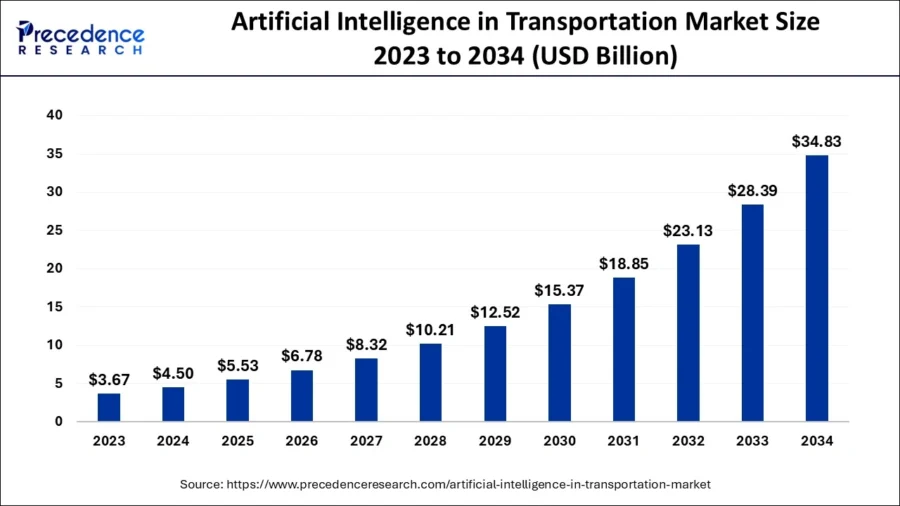
Credit: Precedence Research
Transportlive enables AI-based Fleet Management
Spanish startup Transportlive develops TrafficLive, an AI-powered logistics management solution that connects directly to a transport company’s ERP. It analyzes real-time data from tractors, trailers, drivers, and loading orders to streamline operations.
The platform integrates GPS tracking and PTV mapping to determine optimal routes based on mileage, tolls, location, and driving hours. Every 30 minutes, it updates resource allocation to maintain continuous operations while complying with traffic regulations and international logistics laws.
Its interface includes a dynamic assignment screen with trip priority ratings, allocation waves, and trip-splitting tools for planned and ongoing deliveries. The whiteboard mode allows manual adjustments, while the tracking screen provides a real-time fleet overview with advanced filters.
The key features include real-time status visualization, regulation-aware route planning, driver unavailability management, and actual versus scheduled tracking with alerts. Transportlive allows transportation companies to reduce costs, improve communication, and strengthen decision-making across national and international routes.
Docker Vision identifies Automated Container & Rail Wagon
Indian startup Docker Vision builds dOCR, an AI-powered optical character recognition system that automates port operations by detecting shipping containers, rail wagons, and vehicles in real time.
The platform combines computer vision, deep learning, and machine learning to identify container codes, tare weights, ISO sizes, wagon numbers, and license plates, and integrates this data into port management systems.
It supports on-premise, dockerized deployment with API integration to enable secure, offline data processing within seconds. The solution facilitates terminal gate automation, smart container stacking, and predictive maintenance.
Docker Vision eliminates queues and reduces manual labor to improve truck turnaround time and enhance port productivity.
2. Electric Mobility
New EV registrations will likely reach 18.1 million in 2025, rising from 16.3 million in 2024. However, the growth rate is projected to slow from 15% in 2024 to 11% in 2025, indicating a maturing market.
Moreover, India’s Electric Mobility Promotion Scheme 2024 (EMPS 2024) has allocated approximately USD 60 million over four months to promote adoption in the two- and three-wheeler segment.
Globally, electric buses accounted for 3% of total bus sales in 2023, while electric truck sales increased by 35% year-on-year. China led this segment, with 3% of truck sales being electric, compared to 1.5% in Europe.
As strategies shift, OEMs like GM, Hyundai, and Ford are adjusting EV rollout timelines to prioritize hybrid vehicle investments as a transitional approach. This decision reflects changes in consumer demand, infrastructure challenges, and raw material cost fluctuations.
Further, advances in battery chemistry are improving range and affordability. High-energy density solutions, like lithium-sodium and lithium-titanium, extend driving ranges and reduce charging cycles.
Solid-state batteries are also moving closer to commercialization to offer potential benefits in safety and performance. Lithium iron phosphate (LFP) batteries, although lower in energy density, are gaining traction due to cost efficiency and faster charging times.
Besides, electrified roads present another innovation. Trials of dynamic wireless charging systems embedded in public roads are underway, which enable EVs to charge while moving.
These systems could transform long-distance logistics and mass transit by reducing downtime for recharging – addressing one of the last major hurdles to large-scale EV adoption.
The global electric vehicle market is expected to reach USD 620.33 billion by 2030, reflecting a CAGR of 7.7%.

Credit: Markets and Markets
GreenDrive HUB creates an EV Charging Network
Ghana-based startup GreenDrive HUB makes an electric vehicle infrastructure platform that installs and manages charging stations. It provides tailored solutions for residential, workplace, public, and destination-based charging.
The startup integrates home chargers with automatic billing for multi-family dwellings. This allows developers and landlords to set user-specific pricing and support sustainable housing. For businesses, it offers workplace charging that lowers employee fuel costs, simplifies EV usage, and adds convenience on-site.
The startup’s public charging stations are located in high-traffic areas to ensure accessible and efficient charging for drivers. Meanwhile, its destination charging solutions allow hotels, restaurants, and retail centers to equip parking spaces and generate revenue through flexible funding models.
TRi makes Electric 3-Wheelers
Tanzanian startup TRi manufactures E2, an electric three-wheeler with Internet of Things (IoT) systems. It is offered through a lease-to-own model for African gig drivers. The vehicle features a 4kW motor and an 8kWh LFP battery, delivering over 100 kilometers of range per charge and 2.5-hour fast charging.
The platform integrates real-time telematics and allows remote driver and vehicle performance monitoring. Further, its LCD unit presents on-board data in real time. The key features include heavy-duty suspension for rough roads, high-lumen LED headlights for night driving, and a rear camera for safe parking and navigation.
3. On-Demand Transportation
In FY2024, the US Federal Transit Administration allocated over USD 203 million for research aligned with the Department of Transportation’s strategic goals, including support for on-demand mobility initiatives. Last year, the sector launched more than 390 new projects worldwide.
Via held a 24% market share in the global on-demand transit market in 2024, expanding partnerships with municipalities and transit agencies.
Meanwhile, ride-hailing companies, like Uber and Lyft, continue to integrate AI-driven features like dynamic pricing, real-time vehicle matching, and demand forecasting to reduce wait times and improve service efficiency.
Mobile app ecosystems are also improving user access through real-time tracking, seamless payments, and customizable ride options. This forms the backbone of modern ride-hailing and car-sharing platforms.
On-demand transit addresses social equity by improving mobility for underserved communities, including older adults, children, individuals with disabilities, and households without personal vehicles.
Moreover, on-demand transportation provides travelers with quick and cost-effective alternatives in tourism. GPS integration and real-time data analytics also enable dynamic routing and enhance fleet visibility to support urban mobility and last-mile logistics.
The global on-demand transportation market was valued at USD 166.9 million in 2024 and is expected to grow at a CAGR of 20.1% through 2030.
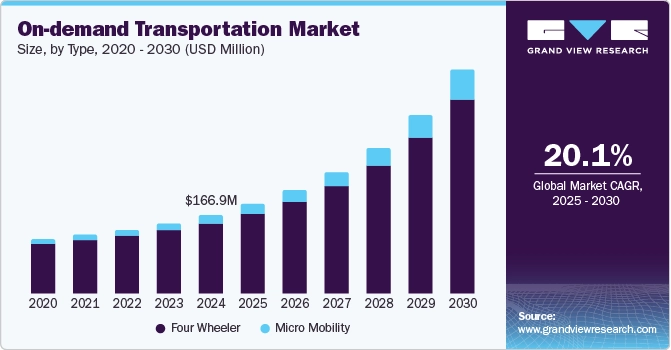
Credit: Grand View Research
AstraCaB simplifies On-Demand Cargo Transport
German startup AstraCaB develops an on-demand cargo transport platform that connects individuals and businesses with professional drivers operating insured commercial vans. It allows travelers to submit transportation requests via a mobile app or website, and drivers accept them in real time. After confirmation, the driver collects goods from the origin and delivers them directly to the destination.
The startup offers vehicle options in four sizes – small, medium, large, and extra-large – each with defined dimensions and payload capacities to meet different transport needs, from small appliances to full household or office moves.
For drivers, the platform provides flexible scheduling, consistent order flow, and weekly payouts. This way, AstraCaB improves cargo delivery with transparent pricing and efficient coordination to support urban freight mobility.
SAIL-E advances On-Demand Sea Transportation
Greek startup SAIL-E offers an on-demand sea transportation platform that connects users with licensed boat operators through a mobile app to support real-time bookings and scheduled maritime travel.
It enables passengers to choose from motorboats, catamarans, yachts, and sailing boats based on their travel needs, whether for leisure or short-distance coastal transport. The platform provides a simplified booking interface, real-time fleet availability, and transparent pricing without hidden fees.
SAIL-E improves coastal connectivity and modernizes short-haul sea travel across Greece’s island and coastal communities.
4. Drone Deliveries
Businesses recorded more than 5 million business-to-consumer (B2C) drone deliveries in the last year. Forecasts suggest this number will rise sharply, reaching 808 million deliveries annually within the next decade.
Further, Amazon plans to deliver 500 million packages per year via drone by 2030, which reflects confidence in autonomous aerial logistics.
After initial authorizations in late 2023, the US Federal Aviation Administration (FAA) expanded permissions in 2024 to allow select operators to conduct “beyond visual line of sight” (BVLOS) flights. This policy shift enabled companies, like Zipline and Wing, to operate in shared airspace without ground-based visual observers.
Moreover, AI and machine learning now support autonomous functions such as object recognition, obstacle avoidance, and real-time path planning. Drones with predictive environmental awareness and adaptive navigation are expected to gain broader commercial use starting this year.
Besides, 5G networks enhance drone connectivity by enabling low-latency communication, real-time flight control, and high-speed data transfer. Additionally, unmanned aircraft system traffic management (UTM) platforms support coordination among multiple drones and operators in crowded airspaces.
Electric drones offer environmental benefits over diesel-powered delivery trucks, particularly in rural areas. Their adoption supports emission-reduction goals and improves last-mile delivery efficiency while lowering carbon footprints.
The global drone logistics and transportation market is expected to reach USD 34.95 billion by 2032, growing at a CAGR of 50.21% between 2024 and 2032.

Credit: Zion Market Research
The Good Drone Company advances Aerial Delivery
US-based startup The Good Drone Company develops autonomous hybrid cargo drones for long-range aerial delivery. Its drones use electric motors for vertical takeoff and landing (VTOL), while a gas engine powers forward flight to reduce downtime through simple refueling.
The startup’s aircraft has a 5-meter wingspan, carries payloads up to 25 kg, reaches altitudes of 3000 meters, and flies autonomously at speeds up to 170 km/h. Its compact VTOL design enables deployment from various locations, regardless of infrastructure.
The Good Drone Company offers full autonomy and infrastructure-independent deployment to improve physical connectivity and expand access to remote and underserved areas.
IONA creates Autonomous Delivery Networks
UK-based startup IONA makes autonomous drone delivery networks that use VTOL drones and robotic ground stations to improve last-mile logistics in rural and underserved areas. Its system combines electric vertical takeoff and landing aircraft with automated hubs for battery swapping and parcel handling.
The startup’s drones feature a tilt-rotor design for efficient vertical and wing-borne flight, while the hubs oversee fleet coordination and maintenance. This setup reduces dependence on underutilized delivery vans, cuts carbon emissions, and strengthens service reliability in low-density regions.
IONA offers a hardware-as-a-service model, which allows logistics providers to expand their reach with scalable, cost-effective solutions in challenging delivery environments.
5. Blockchain Integration
The global blockchain technology market in transportation and logistics is projected to grow by USD 6.91 billion from 2023 to 2028, with a CAGR of 60.82%.
Investments in industrial blockchain are expected to reach USD 11.7 billion this year, with transportation accounting for a significant share.
Further, blockchain enhances supply chain visibility and management by enabling real-time tracking and creating immutable records of shipment locations, environmental conditions, and handoffs. Retailers and manufacturers use the technology to establish digital product histories while improving traceability and accountability.
In payments and documentation, blockchain reduces transaction settlement times from days to minutes by automating verification and approvals. Cross-border transportation has also benefited from improved speed and accuracy in digital documentation and recordkeeping with blockchain.
In addition, smart contracts automate agreements across the transportation sector. These contracts trigger payment releases and updates when conditions like delivery confirmations or customs clearance are met.
123Carbon builds a Carbon Insetting Platform
Dutch startup 123Carbon develops a blockchain-based carbon insetting platform that issues, manages, and allocates environmental attribute certificates (EACs) across transportation modes, including road, rail, sea, air, and barge.
The platform uses the globally accepted book & claim methodology to tokenize verified CO₂-equivalent reductions from low-carbon transport initiatives. Each certificate remains uniquely tracked and immutable.
A secure registry and customizable digital wallets allow users to view, transfer, and report insights, while the system ensures accurate accounting by issuing one certificate per ton of reduced emissions for each actor in the supply chain.
The platform supports branded white-label solutions for carriers and fuel suppliers, enabling them to offer private insetting programs. This way, 123Carbon allows logistics providers and cargo owners to meet Scope 3 decarbonization targets and finance sustainable transport solutions within their value chains.
TCS facilitates Tokenization for Payables and Payroll
US-based startup TCS builds a blockchain-as-a-service platform that allows freight carriers to convert unpaid invoices into digital assets for faster and more cost-effective settlements.
The startup’s platform uses the TCS Token, an ERC-20 utility token on the Polygon network, to tokenize freight invoices. Carriers exchange accounts receivable for tokens and liquidate them for US dollars on digital exchanges.
This process bypasses traditional factoring, which reduces settlement times to 1–2 business days and lowers costs by eliminating intermediaries and associated fees. The TCS Token has a capped supply, with new tokens introduced through truck driver transactions, to align incentives across the supply chain.

6. Autonomous Vehicles
Semi-autonomous vehicles will likely generate USD 236.85 billion in market value by 2025, while fully autonomous models will contribute USD 191.45 billion.
The US may have 3.5 million autonomous vehicles on its roads by 2025, increasing to 4.5 million by 2030 as adoption accelerates.
Nuro recently secured USD 106 million in funding led by Tiger Global, Greylock Partners, and more, reaching a USD 6 billion valuation.
Consumer adoption is also expanding, with nearly 60% of all vehicles sold globally by the end of 2025 expected to include Level 2 autonomy features like adaptive cruise control, lane-keeping assistance, and collision avoidance systems.
Waymo’s partnership with Uber is gaining traction – by late March 2025, Waymo robotaxis accounted for 20% of Uber rides in Austin. This signals increased consumer trust in autonomous transport.
Moreover, large language models (LLMs) and computer vision improve decision-making in complex urban environments, while machine learning optimizes routes, reduces congestion, and lowers emissions in real time.
Freight logistics are also shifting – companies, like TuSimple, are testing driverless depot-to-depot trucking to enhance delivery efficiency and reduce reliance on human drivers.
Additionally, smart cities are adopting vehicle-to-everything (V2X) communication infrastructure to support autonomous vehicle operations in public transit, last-mile delivery, and municipal services such as waste collection.
The global autonomous vehicles market is expected to reach USD 3.08 trillion by 2033, growing at a CAGR of 34.5% between 2024 and 2033.
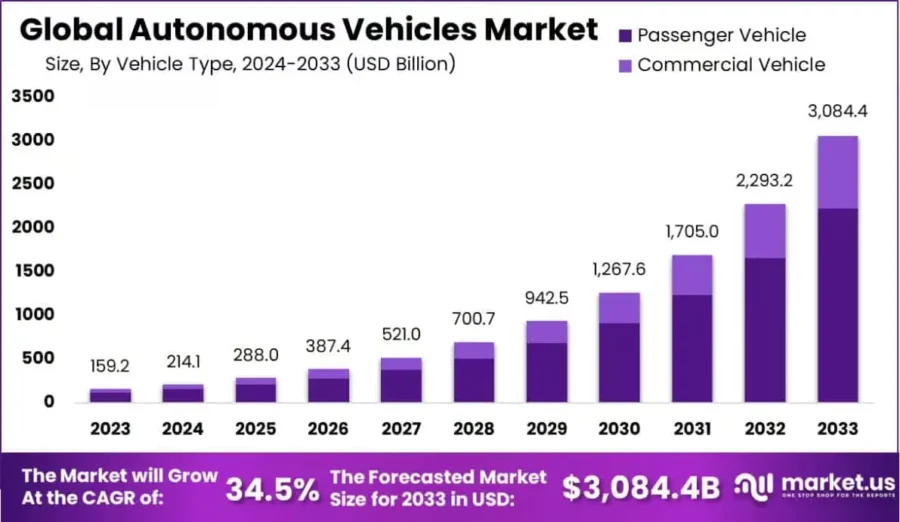
Credit: Market.Us
Airvolve enables Automated Cargo Delivery
Lithuanian startup Airvolve offers a hybrid-electric VTOL aircraft for tactical airlift missions in defense and civil sectors. The aircraft utilizes a horizontal-axis rotor system to reduce noise while maintaining helicopter-like efficiency. Further, a lift-generating fuselage enhances aerodynamic performance.
It carries payloads up to 200 kg within a 5 m³ cargo bay and has a 100 km range, and its compact design allows storage in a 20-foot container without disassembly. The platform supports multiple control modes, including full autonomy, remote piloting, and semi-manual onboard operation. The safety features include anti-FPV protection and minimal thermal emissions.
Airvolve improves logistics, casualty evacuation, and special operations in areas with limited infrastructure or high-risk conditions.
Sigmawave AI provides a Visual Synthetic Data Platform
Singaporean startup Sigmawave AI makes Terra Builder, a visual synthetic data platform that trains and validates autonomous vehicle systems by simulating complex driving scenarios. It generates customizable synthetic datasets that replicate dynamic road conditions. This allows AI models to learn from rare and hazardous events without real-world exposure.
The startup’s platform includes a scene generator, weather configurator, and automatic labeling engine (RobotAL). This enables users to create tailored environments with precise annotations, improving model generalization, reducing development time, and lowering safety risks in testing.
7. Multimodal Transportation
The global multimodal transportation market is expected to reach USD 92.38 billion by 2032, growing at a CAGR of 8.3% from 2024 to 2032.
AI and big data are improving logistics operations as companies like DHL and Maersk deploy these tools to optimize routing and predict delays. These technologies enable companies to reduce fuel consumption, minimize idle time, and strengthen supply chain reliability.
Further, platforms (like Magnify) use cloud-based AI, driver apps, real-time traffic monitoring, and asset tracking to streamline freight management. Magnify’s transfer-point network model supports continuous cargo movement while improving speed, cost efficiency, and safety.
Platooning in road transport, enabled by vehicle-to-vehicle (V2V) communication, is advancing automation and connectivity.
Between 2018 and 2023, more than 1000 patent families were filed annually in this area. This reflects global interest in semi-autonomous truck convoys to lower fuel consumption and improve road efficiency. Infrastructure development also plays a key role in multimodal logistics, especially in emerging markets.
India’s Bharatmala Pariyojana initiative includes 35 Multimodal Logistics Parks (MMLPs) with an estimated investment of USD 5.5 billion.
Moreover, Maersk is using AI to adjust shipping routes dynamically in response to weather disruptions and geopolitical risks. This improves the intermodal transport chain resilience and ensures timely deliveries.
Wise2Go advances Mobility & Space Management
Portuguese startup Wise2Go offers an integrated facility management platform that enhances corporate mobility and workspace efficiency. It coordinates travel planning, corporate rides, and multimodal transport with shared office resources like workstations, parking, and vehicle fleets.
The platform automates route planning, access control, vehicle scheduling, and refund tracking while monitoring carbon emissions from carpooling, cycling, and teleworking for ESG audits. It features emissions management, job and parking reservations, transport and refund control, and sustainable transport incentives.
Further, it supports real-time scheduling, automates boarding for executive transport, and provides carbon footprint insights.
ShipNova improves Third-Party Logistics (3PL) & Supply Chain Management
US-based startup ShipNova provides third-party logistics services through a cloud-based platform that streamlines supply chain operations. Its technology platform, Turvo, connects shippers, carriers, and customers in real time for users to manage orders, track shipments, schedule appointments, and exchange documents.
The system includes live shipment tracking, automated messaging, global search by PO or shipment ID, and end-to-end visibility from load creation to payment. The startup also offers services like full truckload (FTL), less-than-truckload (LTL), consolidated shipping, time-critical delivery, drayage, and customized logistics strategies.
This way, ShipNova improves operational efficiency, reduces communication barriers, and enables shippers to manage costs effectively within complex supply chains.
8. High-Speed Transportation
The global high-speed rail market is expected to reach USD 74.7 billion by 2033, growing at a CAGR of 6.5% between 2023 and 2033.
India’s Cabinet Committee on Economic Affairs approved eight National High-Speed Corridor projects spanning 936 km, with a budget of approximately USD 6 billion. In the UK, the High-Speed 2 (HS2) project is progressing to link London, Birmingham, and Manchester to reduce congestion and improve travel times.
Further, predictive maintenance platforms, real-time data analytics, and automated train control systems enhance efficiency. Automation reduces human error, improves safety, and detects operational disruptions early.
Intelligent signaling and communication systems – including communications-based train control (CBTC), positive train control (PTC), and European rail traffic management system (ERTMS) -support real-time monitoring and optimize network performance.
Additionally, magnetic levitation (maglev) technology is advancing high-speed rail innovation. China’s maglev trains, which operate at speeds up to 600 km/h (373 mph), reduce mechanical wear and maintenance costs while delivering smoother travel.
Moreover, passenger experience improvements are shaping development. Ergonomic seating, onboard Wi-Fi, and integrated digital ticketing systems encourage travelers to shift from short-haul air travel.
Celerity Craft builds a Dynamic Air Cushion Vehicle
Canadian startup Celerity Craft develops Dynamic Air Cushion Vehicle (DACV) technology, a marine propulsion system that lifts vessels above the water’s surface using an energized air cushion.
The startup’s system combines lift and thrust dynamics. The air cushion elevates the vessel and propels it forward by venting air through the stern. This allows higher speeds and lower fuel consumption compared to conventional marine vessels.
The DACV platform supports speeds up to 60 knots and cuts fuel use by 50–70%. Its design also enables full electrification, supporting zero-emission operations. The trimaran hull structure and amphibious capabilities allow navigation in shallow waters and beach landings. The system minimizes underwater noise pollution and reduces risks for marine life.
Celerity Craft’s scalable, modular solution for passenger transport, cargo, military, and search and rescue operations. Its technology addresses environmental and operational challenges while improving marine transportation.
Swissloop Tunneling advances Microtunneling
Swiss startup Swissloop Tunneling makes micro tunnel boring machines (MTBMs) that integrate excavation, steering, and in-situ tunnel lining to support urban tunneling and high-speed transportation projects.
Its latest prototype, Groundhog Beta, features a hydraulic hexapod steering system with six degrees of freedom for precise curved tunneling. A polymer extrusion unit 3D-prints a 15 mm thick tunnel wall using polypropylene granulate reinforced with fiberglass lamellas.
The machine’s propulsion system operates with coordinated hydraulic cylinders that press against tunnel walls to enable continuous forward motion. Its surface-level starting platform eliminates the need for vertical launch shafts, reducing setup time.
Swissloop Tunneling combines excavation, navigation, and tunnel lining into a single compact system to lower construction costs, limit environmental impact, and speed up underground infrastructure deployment in dense urban areas.
9. 5G Technology
India’s Ministry of Housing and Urban Affairs allocated USD 600 million in 2024 for smart transportation projects, including 5G-enabled metro rail systems in cities like Delhi, Mumbai, and Bengaluru.
Further, 5G-powered V2X communication supports autonomous mobility and intelligent road systems by enabling real-time interactions among vehicles, infrastructure, and pedestrians.
China has embedded smart sensors along 5000 kilometers of highways and upgraded more than 300 intersections in cities like Beijing and Shanghai with V2X capabilities.
Fleet management is evolving as 5G connects up to 1 million devices per square kilometer. This increases data throughput and reduces latency. The connectivity enables real-time diagnostics, predictive maintenance, and vehicle health monitoring – resulting in extending fleet lifecycles and minimizing downtime.
In public transit, 5G enhances real-time tracking, automates fare systems, and optimizes traffic flow with AI. Besides, rail operators across Europe and Asia use 5G to improve operational reliability and passenger experiences with high-speed connectivity and process automation.
Additionally, 5G-enabled intelligent traffic systems are converting urban infrastructure by integrating dynamic traffic signal controls, congestion management, and emissions reduction.
The global 5G in automotive and smart transportation market is expected to reach USD 31.18 billion by 2034, with a CAGR of 28.32%.

Credit: Precedence Research
EasyStreet Systems facilitates Small Cell Infrastructure
US-based startup EasyStreet Systems manufactures composite smart poles for transportation and telecom infrastructure. These lightweight poles offer a crash-friendly alternative to steel structures for 4G/5G small-cell and IoT deployments.
The poles have a patented composite construction with a UV-resistant coating and RF-transparent finish. This allows concealed integration of antennas and radio equipment within color-matched toppers. They support direct burial and retrofitting onto existing foundations with precast ballast.
The poles are available in heights from 20 to 50 feet and withstand winds up to 180 mph, and work with small-cell, microwave, and IoT equipment. The system supports multi-carrier co-location and offers customizable textures, colors, and decorative finishes.
Microamp builds 5G mmWave Networks
Polish startup Microamp develops 5G mmWave networks for public transit systems, deploying compact, tunnel-optimized radios and gNodeBs to maintain multi-gigabit connectivity in subways, local trains, and transport hubs. The system uses directional mmWave signals to overcome traditional network limitations and delivers low-latency, high-bandwidth communication in dense urban areas and underground tunnels.
It enables passenger connectivity by providing Wi-Fi access throughout the journey, which allows commuters to stream, work, and use social media without disruption. At the same time, the network improves operational efficiency by supporting instant communication, dynamic scheduling, and AI-driven traffic coordination.
The safety features include emergency response system integration and AI-enabled surveillance for continuous monitoring. The infrastructure also enhances smart transit management by processing real-time data from IoT sensors to support predictive maintenance and energy optimization.
10. Mobility-as-a-Service
The global mobility-as-a-service market is expected to exceed USD 754.34 billion by 2032, growing at a CAGR of 17.4% as demand increases for integrated and cost-effective transportation solutions.
GreenCell Mobility’s deployment of 150 intra-city electric buses in Ayodhya, India. This reflects the expansion of electric mobility-as-a-service (eMaaS), which focuses on carbon-neutral operations and government-private collaboration.

Credit: SNS Insider
In Europe, Athens launched a multimodal MaaS pilot in early 2024 through Transport for Athens (OASA), integrating contactless fare systems with taxis, ferries, airlines, and e-bikes to improve urban connectivity.
AI and machine learning are transforming MaaS by enabling dynamic traffic management, predictive routing, and automation across transportation networks. These technologies extend to parking, toll systems, and commuter analytics to support smart city transport frameworks.
Innovations like Be-In, Be-Out (BIBO) ticketing and proximity-based transmission (like ultrasonic signals) are replacing traditional fare systems to improve accessibility.
Subscription-based mobility plans and increasing consumer demand for flexible, all-in-one travel apps are driving adoption. Investments in electric and autonomous vehicles are expanding MaaS platforms to offer more sustainable transportation options.
Further, smartphone use, urbanization, and climate policies are reinforcing the shift toward MaaS as companies look to lower fleet costs. By replacing vehicle ownership with usage-based access and data-driven fleet management, businesses improve efficiency while reducing environmental impact.
Zenmov develops a Cloud-based Smart Mobility Platform
Japanese startup Zenmov provides the Smart Mobility Operation Cloud (SMOC), a cloud-based platform that integrates AI-driven scheduling, real-time fleet coordination, and multimodal transit management to improve public transportation in congested urban areas.
SMOC consists of four core components. The passenger app enables vehicle tracking, e-ticketing, and on-demand ride requests. The driver app provides dynamic spacing instructions and job lists. Further, the operator dashboard monitors live operations and generates optimized schedules, and the backend engine analyzes historical data to forecast demand and automate route planning.
The system maintains evenly spaced vehicle intervals without fixed timetables, supports fixed-route and on-demand services, and coordinates electric buses, autonomous vehicles, and bicycles.
Consequently, SMOC powers services like primary rapid transit and autonomous bus networks to reduce emissions and improve commuter convenience. Zenmov enables transit operators and municipalities to modernize mobility infrastructure and address urban transportation challenges.
Fleetune builds a Transportation Management System
South Korean startup Fleetune offers an AI-powered fleet management platform that improves logistics operations by integrating real-time vehicle tracking, predictive maintenance, and driver behavior analytics.
The system processes data from onboard diagnostics and GPS sensors, which enables fleet managers to monitor vehicle health, fuel consumption, and route efficiency through a centralized dashboard. It automates maintenance scheduling, issues alerts for mechanical problems, and identifies unsafe driving patterns such as harsh braking or speeding.
Additionally, the platform supports compliance tracking and generates reports to assist with regulatory adherence and operational decisions.
Discover all Transportation Trends, Technologies & Startups
The transportation industry is advancing beyond current trends, with hydrogen-powered vehicles offering a cleaner option for long-haul and heavy-duty transport. Digital twin simulations model traffic patterns and improve infrastructure planning, while predictive mobility analytics enable cities and operators to anticipate demand surges and adjust transit systems accordingly. These innovations support the development of more resilient and efficient transportation networks.
The Transportation Trends & Startups outlined in this report only scratch the surface of trends that we identified during our data-driven innovation & startup scouting process. Identifying new opportunities & emerging technologies to implement into your business goes a long way in gaining a competitive advantage.
